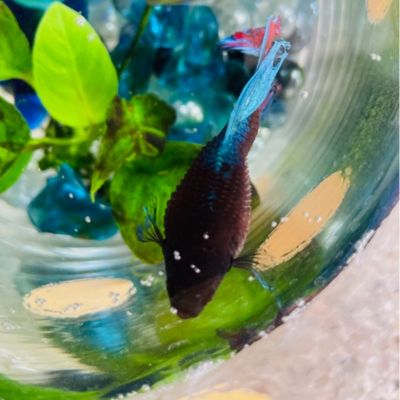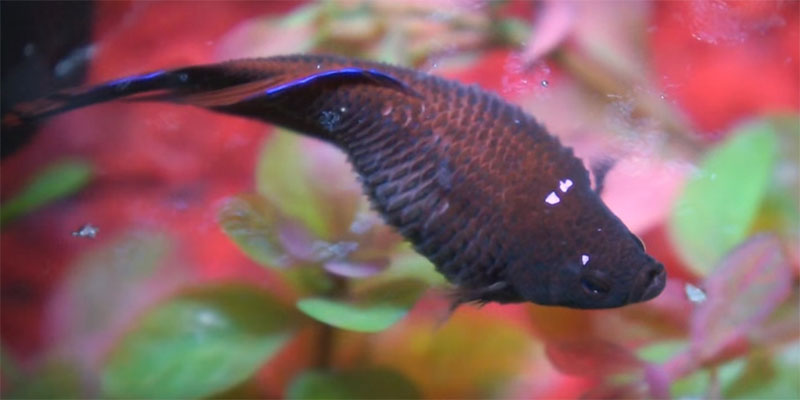
Quick Summary
Name: Fish Dropsy
Scientific Name: Depends on what caused it as it’s a secondary symptom
Cause: Usually caused by a bacterial infection, virus or parasite
Visual Symptoms: Extreme swelling of the body and pine coning of scales
Behavioral Symptoms: Lack of appetite, lethargy, bottom-dwelling, darting to the surface for oxygen, and lying on their side
Treatment: Antibiotics like Kanamycin, or Maracyn II
Outlook: Usually fatal
Dropsy in betta fish is not a disease but a secondary symptom of another problem internally. Think of this like when you have an infected cut and a secondary symptom can be warm skin or swelling surrounding the cut.
Chances for survival are more common with less severe internal causes and immediate treatment. The sooner you notice the pinecone-like appearance or swelling, the better the odds are for successful treatment. The survival rate for betta fish with dropsy is low.
Dropsy Symptoms in Betta Fish
The iconic symptom of dropsy is the visual bloat and swelling of the stomach which causes a betta’s scales to flare out and present a pinecone appearance. This is different than overfeeding and constipation bloat which is contained only in the stomach area. Dropsy is easily identified by looking down on your betta from above. Other symptoms include virtually non-existent appetites, extreme lethargy, darting to the surface to gasp for air, and color loss.
What Causes Dropsy in Betta Fish?
Dropsy is typically caused by a gram-negative bacterial infection. Prolonged stress weakens a bettas immune system and prevents it from fighting off the infection.
Dropsy is also linked to kidney failure, poor diet, bad osmoregulation, and other internal organ infections (e.g. liver). Its physical appearance is caused by internal swelling from fluid building up and placing pressure against the body and abdominal area. Aging bettas are also more prone to kidney failure and other bacterial and parasitic infections, which increases their risk for dropsy.
High bio-loads from too many tank mates or too small of an ecosystem can cause harmful infections and bacteria to manifest rapidly. Live food and proteins not recommended for betta fish consumption can also cause digestive issues and kidney failure. Read more on proper betta fish food and feeding.
How to Treat Dropsy in Betta Fish
Dropsy is usually fatal in advanced stages (extreme bloating). Identifying it early will increase your chances for successful treatment. Follow the instructions below to treat your betta fish for dropsy:
- Prepare a hospital tank
- Add a heater with a built-in thermostat and keep it around 78 degrees Fahrenheit
- Keep the water level lower than normal to make it easy for your betta to surface for oxygen
- Add an air stone with an air pump to oxygenate the tank’s water. (antibiotics can deplete oxygen levels)
- Add aquarium salt (optional) to the hospital tank at a rate of 0.5 teaspoons per gallon.
- This will help reduce swelling and release built-up fluids. Make sure it’s fully dissolved.
- Acclimate your betta fish to the hospital tank
- Administer the antibiotic according to its directions.
- Never stop treatment early
Hospital tanks are highly recommended for ease of dosing and treatment. They are optional if you don’t have live plants or other tank mates. Treating in the main tank, however, can disrupt the nitrogen cycle. Never pour the hospital tank’s water back into your main aquarium once you are done with treatment.
Some medications may require removing your carbon filter media or recommend stopping partial water changes during treatment. If a water test shows parameters spiking you may need to use a water conditioner that detoxifies ammonia, and nitrite and helps reduce nitrate.
Acclimate your betta back into the main habitat once treatment is complete.
Dropsy Medication
The best medications for dropsy treatment in bettas are Kanaplex from Seachem and Maracyn Two from Fritz Aquatics. The active ingredient in KanaPlex is kanamycin and Maracyn Two’s active ingredient is minocycline. These broad-spectrum antibiotics can be easily absorbed via the skin and gills. This is especially helpful if the betta is no longer eating.
Strong antibiotics can also affect the kidneys and the liver placing additional stress on a betta. This is why even with treatment, it’s possible that your betta fish will not survive dropsy. You should still try to treat it and keep your betta comfortable during this time. Some betta owners may also consider euthanasia depending on the betta’s age and outlook for recovery. It’s a difficult decision only you can make when analyzing the quality of life the betta is currently experiencing.
How to Prevent Dropsy in Bettas
Dropsy is best prevented through proper care. This includes the right size habitat, partial water changes, cleaning schedules, maintaining a tropical habitat (78 degrees Fahrenheit), and feeding high-quality food.
Dropsy in betta fish is more prevalent in small habitats (2 gallons or less) and poor water conditions. I recommend a 5-gallon tank with a heater and filter which makes it easier to maintain a betta’s ideal water parameters.
Reducing and preventing stressors will keep your betta fish’s immune system healthy. This is their natural ability to resist and fight infections and disease. Ammonia, nitrite, and nitrate levels should be monitored routinely. Use feeding times to inspect your betta fish for any signs of illness or abnormalities.



